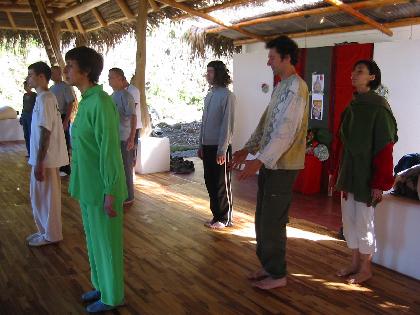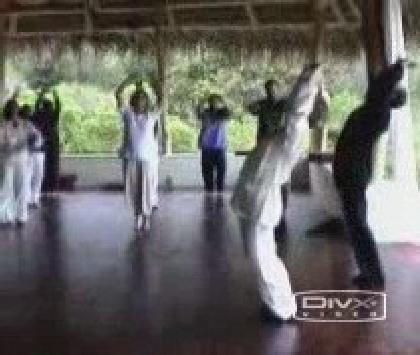QUESTIONS ON YI JIN JING OR SINEW METAMORPHOSIS

Sinew Metamorphosis is such a powerful exercise in our school that it is understandable many people may think we are lying when if we describe what we do and attain. For example, by just flicking our hands three times, we can generate tremendous amount of internal force or expand our spirit to meet God! The photograph above shows students in a regional course in Costa Rica enjoying such an effect during Standing Meditation after flicking their hands three times in Sinew Metamorphosis.
Questions on Jijin Jing or Sinew Metamorphosis
I have read some books describing Yijin Jing (Sinew Metamorphosis) as a form of Waidan gong (not the Waidan gong created by the Taiwanese Muslim master, but in a more generic sense).
Waidangong was defined in these books as exercises that generated qi by “tensing” or “stimulating” the limbs and then circulating the qi around the body. Neidangong in contrast is the art of generating the qi at the dantian rather than at the extremities. Sifu, in your esteemed opinion, are such definitions accurate? I had thought that qi is gathered in the dantian after practice, but not created or generated there.
Zhang Wuji
Sifu's Comments
We should note that what they differentiate is between waidangong (or external elixir development) and neidangong (or internal elixir development), and not between waigong (external art) and neigong (internal art). In this context, waidangong is still neigong or internal art.
The definitions they use are quite established. Although they are accurate, I seldom use the definitions nor the terms “waidangong” and “neidangong” because while they apply quite well to other schools of qigong, they may become irrelevant in our school. This in turn is because while other schools are quite definite in the way they develop and manage qi, we are quite versatile. In other words, in most schools when practitioners use method A, they will have result B. In our school, when we use method A, we may have results B, X, Y or Z, depending on various factors like our needs and purposes.
Hence, in most schools qigong exercises like “Lifting the Sky” and “Pushing Mountain” are regarded as waidangong, whereas “Abdominal Breathing” and “sitting meditation” as neidangong. Sinew Metamorphosis, as is commonly practiced, would be waidangong. But calling Sinew Metamorphosis in Shaolin Wahnam a waidangong exercise would be very misleading, as it may connate that it is less internal and less powerful than what it actually is.
In our school, whether qi is gathered or generated at the dan tian is a matter of semantics or of preference. While I congratulate you for your sharp observation, I find it an academic issue. In other words, when we find qi at our dan tian as a result of practicing “Lifting the Sky” or “Abdominal Breathing”, we are usually not concerned whether the qi is originally generated at the dan tian, or it was generated somewhere else then brought to gather there when we think of the dan tian.
But when we pay attention to the issue, if we are skilful we can decide whether to generate or gather qi at the dan tian. When we perform “Lifting the Sky”, for example, we can focus at our dan tian on each move, so that the amount of qi grows at the dan tian and is not brought there from elsewhere. Alternatively, we may generate qi at our arms and other parts of our body, then bring the qi to gather at our dan tian when we go into Standing Meditation.
Nevertheless, argument may arise even when we generate qi at the dan tian (as opposed to gathering it there), whether qi really is generated at the dan tian and not at the space adjacent to it, or even at the space outside the body or in other parts of the body. The debaters may logically ask if qi is really generated at the dan tian, how is it generated. Is the qi generated due to the breaking up of some sub-atomic particles (jing transforming into qi), or is it absorbed into the body from the cosmos, in which case it is gathered at and not generated in the dan tian. We are generally not interested in such debates, although they may give us some intellectual pleasure.
Wong Kiew Kit
 We in Shaolin Wahnam believe that “Xisui Jing” or “Marrow Cleansing” refers to the art of cleansing nerves rather than a definite form of exercise. This art of nerve cleansing may be achieved by using various techniques, such as “Carrying the Moon” as shown a regional qigong class called “Golden Shower” in Costa in February 2005.
We in Shaolin Wahnam believe that “Xisui Jing” or “Marrow Cleansing” refers to the art of cleansing nerves rather than a definite form of exercise. This art of nerve cleansing may be achieved by using various techniques, such as “Carrying the Moon” as shown a regional qigong class called “Golden Shower” in Costa in February 2005.
In Dr Yang's latest book, he wrote that Yijin Jing and Xisui Jing are two parts of a complete qigong exercise, with Yijin Jing being a yang set, while Xisui Jing being a yin set. This is the first time I have heard anything of this sort and am frankly puzzled. I recall Sifu explaining to me before that:
“Damo's Xi Sui Jing, or Bodhidharma's Art of Marrow Cleansing, is not lost. My research has led me to conclude that unlike his other two great arts, Eighteen Lohan Hands and Sinew Metamorphosis, which were recorded in kungfu classics, the Art of Marrow Cleansing is not found in any records because it does not have any definite forms.”: April 2004 (Part 2).
This is only of academic interest to me, but I was naturally curious why Dr Yang would attribute yin and yang properties to Damo's arts. The yin and yang concept may have been added later as Shaolin Kungfu became more “Chinese” but I don't think that the concept was inherent in Xisui and Yijin Jing when Damo first created them.
Zhang Wuji
Sifu's Comments
Dr Yang must have good reasons for using yin-yang to describe Xisui Jing (Marrow Cleansing) and Yijin Jing (Sinew Metamorphosis). If I were to regard Xisui Jing as an art with definite form, I would agree with Dr Yang that Yijin Jing being “harder” as it strengthens the sinews, is yang, and Xisui Jing being “softer” as it cleanses the nerves, as yin.
However, as you have stated, my view is that Xisui Jing does not have definite form, but refers to the skill of cleansing nerves. Thus, if the practitioner is skilful, any art form or any qigong exercise, like Yijin Jing or “Carrying the Moon”, can be used to cleanse the nerves and be referred to as Xisui Jing.
As a comparison, chi flow is a signature skill in our school. Our students can use any technique or qigong exercise to generate a chi flow. Those who do not make a difference between skills and techniques may not understand what we are saying here. This is also a main reason why they derive little results despite having learnt many techniques and practiced for a long time.
It is worthy to note that when Bodhidharma asked his students to describe their attainment, he told some that they had attained the “skin” of his teaching, and others that they had attained the “flesh”. Only to Hei Ke, his best student who later succeeded Bodhidharma, the master said he had attained the “bones and marrow”.
Qigong masters have discovered that qi flows at five different levels. At the surface it flows along the skin. When you perform “Lifting the Sky” and feel as if there were hundreds of insects clawing over you, it is an indication of qi flowing along your skin.
Then as qi gets deeper, it flows along the flesh or muscles. Among other benefits, Golden Bridge produces this effect, making your arms solid and powerful like iron.
Next, qi flows along the meridians. “Small Universe” or “Micro-Cosmic Flow” focuses on this aspect of qi flow.
From the merdians, qi flows to the internal organs. “Separating Water” and “Nourishing Kidneys” are two of our Eighteen Lohan Hands that specially direct qi into the lungs and kidneys.
At the deepest level, qi flows inside the bones and marrow, which in Chinese often refers to the nerves. “Turning Cosmos” (which is a more poetic name for “Turning Head”) of our Eighteen Lohan Hands achieves this effect when practiced at advanced levels.
When you appreciate the differentiate between skills and techniques, you will notice that in the above examples I give five different types of techniques to achieve various levels of qi flow in our body. But when you have the skills, you can use any one technique to achieve any one or all the qi flow levels. In fact you and the other course members at the recent Sabah Intensive Course (June 2005) learned this skill except that we did not direct qi flow to different depth levels but to different parts of our body and at different speed.
Wong Kiew Kit
- The Evolution of Taijiquan from Shaolinquan
- General Practice and Training, and Sparring Methodology
- Combat Philosophy on Retreat and Yielding
- Difference in Stances
- The Use of Internal Force
- Fa-jing and Qin-na
- Academic Questions and Direct Experiences
- Yin-Yang, God and Health
- Spirituality and Over-Training
- Questions on Sinew Metamorphosis
- Questions on Breathing Methods and Control
- Taoist Philosophy and Concept of Open and Close
LINKS
